Stratigraphy of Fresco Paintings: A New Approach with Photoacoustic and SORS Imaging
Abstract
1. Introduction
2. Materials and Methods
2.1. Samples
2.1.1. Real Samples of Fresco
2.1.2. Mock Up Samples of Fresco Paint
2.2. PA Imaging Setup
2.3. Cross-Section SEM Images
2.4. Raman Spectroscopy and SORS
3. Results
3.1. Frescoes from San Giuseppe Church
3.2. PA and SORS on Fresco Mock-Ups: Comparing Limits and Applicability
4. Conclusions
Author Contributions
Funding
Institutional Review Board Statement
Informed Consent Statement
Data Availability Statement
Acknowledgments
Conflicts of Interest
References
- Kim, S.; Chen, Y.-S.; Luke, G.P.; Emelianov, S.Y. In vivo three-dimensional spectroscopic photoacoustic imaging for monitoring nanoparticle delivery. Biomed. Opt. Express 2011, 2, 2540–2550. [Google Scholar] [CrossRef] [PubMed]
- Mallidi, S.; Larson, T.; Tam, J.; Joshi, P.P.; Karpiouk, A.; Sokolov, K.; Emelianov, S. Multiwavelength photoacoustic imaging and plasmon resonance coupling of gold nanoparticles for selective detection of cancer. Nano Lett. 2009, 9, 2825–2831. [Google Scholar] [CrossRef] [PubMed]
- Hui, J.; Li, R.; Phillips, E.H.; Goergen, C.J.; Sturek, M.; Cheng, J.X. Bond-selective photoacoustic imaging by converting molecular vibration into acoustic waves. Photoacoustics 2016, 15, 12277–12285. [Google Scholar] [CrossRef] [PubMed]
- Manohar, S.; Vaartjes, S.E.; van Hespen, J.C.G.; Klaase, J.M.; van den Engh, F.M.; Steenbergen, W.; van Leeuwen, T.G. Initial results of in vivo non-invasive cancer imaging in the human breast using near-infrared photoacoustics. Opt. Express 2007, 43, 7132–7170. [Google Scholar] [CrossRef] [PubMed]
- Nie, L.; Chen, X. Structural and functional photoacoustic molecular tomography aided by emerging contrast agents. Chem. Soc. Rev. 2014, 43, 7132–7170. [Google Scholar] [CrossRef]
- Dal Fovo, A.; Tserevelakis, G.J.; Klironomou, E.; Zacharakis, G.; Fontana, R. First combined application of photoacoustic and optical techniques to the study of an historical oil painting. Eur. Phys. J. Plus 2021, 136, 757. [Google Scholar] [CrossRef]
- Tserevelakis, G.J.; Chaban, A.; Klironomou, E.; Melessanaki, K.; Striova, J.; Zacharakis, G. Revealing hidden features in multilayered artworks by means of an epi-illumination photoacoustic imaging system. J. Imaging 2021, 7, 183. [Google Scholar] [CrossRef]
- Tserevelakis, G.J.; Vrouvaki, I.; Siozos, P.; Melessanaki, K.; Hatzigiannakis, K.; Fotakis, C.; Zacharakis, G. Photoacoustic imaging reveals hidden underdrawings in paintings. Sci. Rep. 2017, 7, 747. [Google Scholar] [CrossRef]
- Tserevelakis, G.J.; Siozos, P.; Papanikolaou, A.; Melessanaki, K.; Zacharakis, G. Non-invasive photoacoustic detection of hidden underdrawings in paintings using air-coupled transducers. Ultrasonics 2019, 98, 94–98. [Google Scholar] [CrossRef]
- Tserevelakis, G.J.; Tsagkaraki, M.; Siozos, P.; Zacharakis, G. Uncovering the hidden content of layered documents by means of photoacoustic imaging. Strain 2019, 55, e12289. [Google Scholar] [CrossRef]
- Tserevelakis, G.J.; Pozo-Antonio, J.S.; Siozos, P.; Rivas, T.; Pouli, P.; Zacharakis, G. On-line photoacoustic monitoring of laser cleaning on stone: Evaluation of cleaning effectiveness and detection of potential damage to the substrate. J. Cult. Herit. 2019, 35, 108–115. [Google Scholar] [CrossRef]
- Papanikolaou, A.; Tserevelakis, G.J.; Melessanaki, K.; Fotakis, C.; Zacharakis, G.; Pouli, P. Development of a hybrid photoacoustic and optical monitoring system for the study of laser ablation processes upon the removal of encrustation from stonework. Opto Electron. Adv. 2020, 3, 190037. [Google Scholar] [CrossRef]
- Adam, A.J.L.; Planken, P.C.M.; Meloni, S.; Dik, J. TeraHertz imaging of hidden paint layers on canvas. Opt. Express 2009, 17, 3407–3416. [Google Scholar] [CrossRef]
- Wu, Q.; Hewitt, T.D.; Zhang, X.C. Two-dimensional electro-optic imaging of THz beams. Appl. Phys. Lett. 1996, 69, 1026–1028. [Google Scholar] [CrossRef]
- Redo-Sanchez, A.; Heshmat, B.; Aghasi, A.; Naqvi, S.; Zhang, M.; Romberg, J.; Raskar, R. Terahertz time-gated spectral imaging for content extraction through layered structures. Nat. Commun. 2016, 7, 12665. [Google Scholar] [CrossRef]
- Filippidis, G.; Massaouti, M.; Selimis, A.; Gualda, E.J.; Manceau, J.M.; Tzortzakis, S. Nonlinear imaging and THz diagnostic tools in the service of cultural heritage. Appl. Phys. A Mater. Sci. Process. 2012, 106, 257–263. [Google Scholar] [CrossRef]
- Liang, H.; Cid, M.G.; Cucu, R.G.; Dobre, G.M.; Podoleanu, A.G.; Pedro, J.; Saunders, D. En-face optical coherence tomography—A novel application of non-invasive imaging to art conservation. Opt. Express 2005, 13, 6133–6144. [Google Scholar] [CrossRef]
- Targowski, P.; Iwanicka, M. Optical coherence tomography: Its role in the non-invasive structural examination and conservation of cultural heritage objects—A review. Appl. Phys. A Mater. Sci. Process. 2012, 106, 257–263. [Google Scholar] [CrossRef]
- Dal Fovo, A.; Sanz, M.; Mattana, S.; Oujja, M.; Marchetti, M.; Pavone, F.S.; Cicchi, R.; Fontana, R.; Castillejo, M. Safe limits for the application of nonlinear optical microscopies to cultural heritage: A new method for in-situ assessment. Microchem. J. 2020, 154, 104568. [Google Scholar] [CrossRef]
- Villafana, T.E.; Brown, W.P.; Delaney, J.K.; Palmer, M.; Warren, W.S.; Fischer, M.C. Femtosecond pump-probe microscopy generates virtual cross-sections in historic artwork. Proc. Natl. Acad. Sci. USA 2014, 111, 1708–1713. [Google Scholar] [CrossRef]
- Oujja, M.; Agua, F.; Sanz, M.; Morales-Martin, D.; García-Heras, M.; Villegas, M.A.; Castillejo, M. Multiphoton Excitation Fluorescence Microscopy and Spectroscopic Multianalytical Approach for Characterization of Historical Glass Grisailles. Talanta 2021, 230, 122314. [Google Scholar] [CrossRef] [PubMed]
- Wu, H.-I.; Wang, L.V. Biomedical Optics: Principles and Imaging—Wang; Wiley Online Library: Hoboken, NJ, USA, 2007; Volume 46, pp. 476–482. [Google Scholar]
- Wang, Y.; Wang, L.V. Förster resonance energy transfer photoacoustic microscopy. J. Biomed. Opt. 2012, 17, 086007. [Google Scholar] [CrossRef] [PubMed]
- Conti, C.; Colombo, C.; Realini, M.; Matousek, P. Subsurface analysis of painted sculptures and plasters using micrometre-scale spatially offset Raman spectroscopy (micro-SORS). J. Raman Spectrosc. 2015, 46, 476–482. [Google Scholar] [CrossRef]
- Botteon, A.; Colombo, C.; Realini, M.; Bracci, S.; Magrini, D.; Matousek, P.; Conti, C. Exploring street art paintings by microspatially offset Raman spectroscopy. J. Raman Spectrosc. 2018, 46, 476–482. [Google Scholar] [CrossRef]
- Gierlinger, N.; Schwanninger, M. The potential of Raman microscopy and Raman imaging in plant research. Spectroscopy 2007, 21, 69–89. [Google Scholar] [CrossRef]
- Chiriu, D.; Desogus, G.; Pisu, F.A.; Fiorino, D.R.; Grillo, S.M.; Ricci, P.C.; Carbonaro, C.M. Beyond the surface: Raman micro-SORS for in depth non-destructive analysis of fresco layers. Microchem. J. 2020, 153, 104404. [Google Scholar] [CrossRef]
- Conti, C.; Botteon, A.; Colombo, C.; Realini, M.; Matousek, P.; Vandenabeele, P.; Laforce, B.; Vekemans, B.; Vincze, L. Contrasting confocal XRF with micro-SORS: A deep view within micrometric painted stratigraphy. Anal. Methods 2018, 10, 3837–3844. [Google Scholar] [CrossRef]
- Piovesan, R.; Mazzoli, C.; Maritan, L.; Cornale, P. Fresco and lime-paint: An experimental study and objective criteria for distinguishing between these painting techniques. Archaeometry 2012, 54, 723–736. [Google Scholar] [CrossRef]
- Regazzoni, L.; Cavallo, G.; Biondelli, D.; Gilardi, J. Microscopic Analysis of Wall Painting Techniques: Laboratory Replicas and Romanesque Case Studies in Southern Switzerland. Stud. Conserv. 2018, 63, 326–341. [Google Scholar] [CrossRef]
- Cavallo, G.; Vergani, R.C.; Gianola, L.; Meregalli, A. Archaeological, stylistic and scientific research on 11th–13th century ad painted fragments from the san giovanni battista church in cevio (Switzerland). Archaeometry 2012, 54, 294–310. [Google Scholar] [CrossRef]
- Chiriu, D.; Ricci, P.C.; Scattini, M.; Polcaro, A.; D’Andrea, M.; Richard, S.; Qader, A.A.; Carbonaro, C.M. Portable NIR Raman microspectroscopy investigation on Early Bronze IV pottery (2500–1950 BCE) from Khirbat Iskandar, Jordan. Vib. Spectrosc. 2018, 97, 8–15. [Google Scholar] [CrossRef]
- Pawlyta, M.; Rouzaud, J.N.; Duber, S. Raman microspectroscopy characterization of carbon blacks: Spectral analysis and structural information. Carbon 2015, 84, 479–490. [Google Scholar] [CrossRef]
- Buzgar, N.; Apopei, A.I. The Raman study of certain carbonates. Anal. Şt. Univ. “Al. I. Cuza” Iaşi, Geol. 2009, 2, 97–112. [Google Scholar]
- Rutt, H.N.; Nicola, J.H. Raman spectra of carbonates of calcite structure. J. Phys. C Solid State Phys. 1974, 7, 4522–4528. [Google Scholar] [CrossRef]
- Marcaida, I.; Maguregui, M.; Morillas, H.; Prieto-Taboada, N.; Veneranda, M.; Fdez-Ortiz de Vallejuelo, S.; Martellone, A.; Nigris, B.; Osanna, M.; Madariaga, J.M. In situ non-invasive multianalytical methodology to characterize mosaic tesserae from the House of Gilded Cupids, Pompeii. Herit. Sci. 2019, 7, 3. [Google Scholar] [CrossRef]
- Chamritski, I.; Burns, G. Infrared—And raman-active phonons of magnetite, maghemite, and hematite: A computer simulation and spectroscopic study. J. Phys. Chem. B 2005, 109, 4965–4968. [Google Scholar] [CrossRef]
- Antunes, V.; Candeias, A.; Oliveira, M.J.; Longelin, S.; Serrão, V.; Seruya, A.I.; Coroado, J.; Dias, L.; Mirão, J.; Carvalho, M.L. Characterization of gypsum and anhydrite ground layers in 15th and 16th centuries Portuguese paintings by Raman Spectroscopy and other techniques. J. Raman Spectrosc. 2014, 45, 1026–1033. [Google Scholar] [CrossRef]
- Berenblut, B.J.; Dawson, P.; Wilkinson, G.R. A comparison of the Raman spectra of anhydrite (CaSO4) and gypsum (CaSO4).2H2O). Spectrochim. Acta Part A Mol. Spectrosc. 1973, 29, 29–36. [Google Scholar] [CrossRef]
- Pisu, F.A.; Chiriu, D.; Ricci, P.C.; Carbonaro, C.M. Defect Related Emission in Calcium Hydroxide: The Controversial Band at 780 cm−1. Crystals 2020, 10, 266. [Google Scholar] [CrossRef]
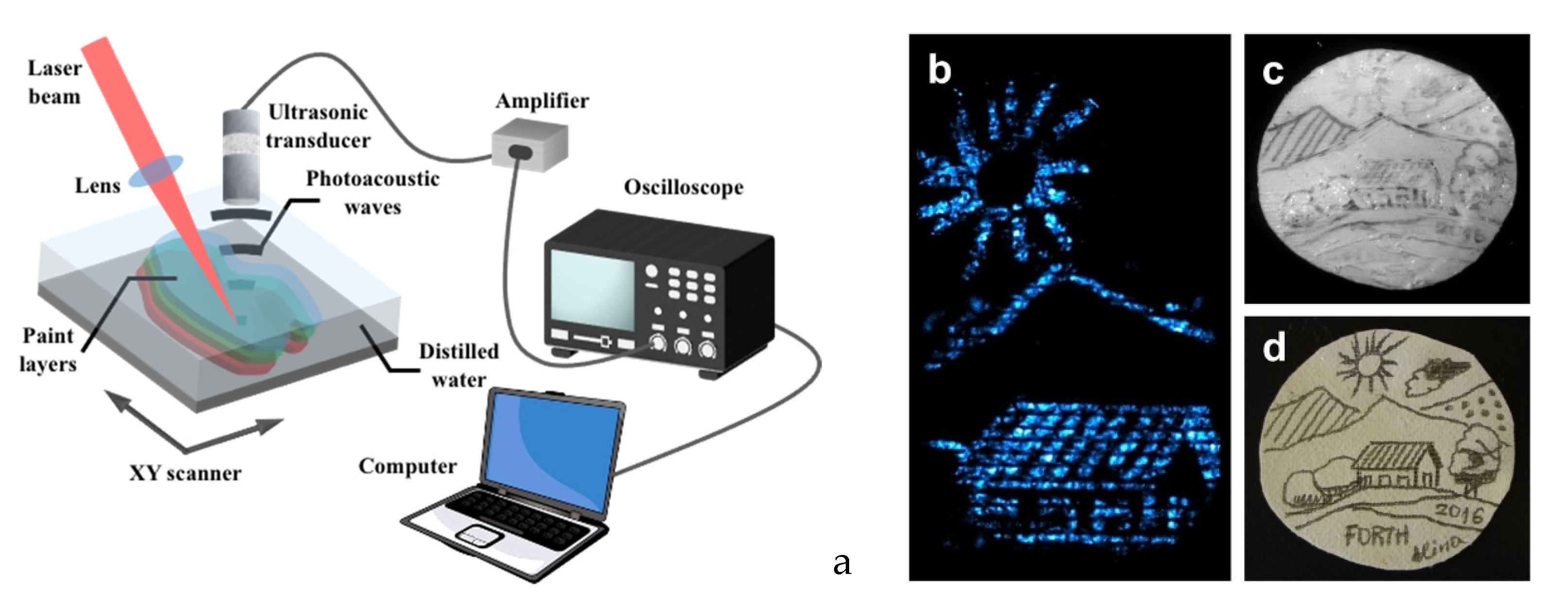

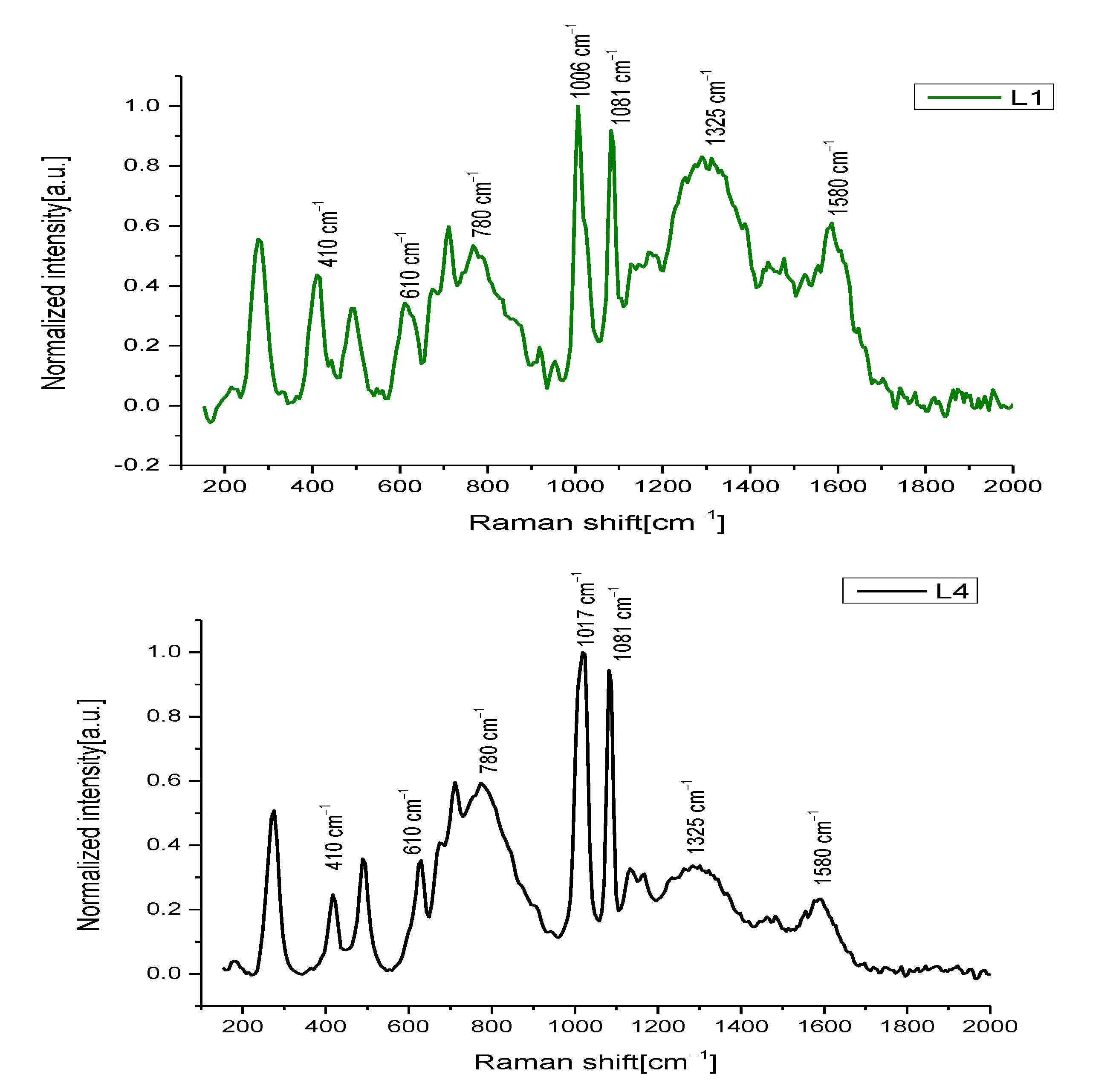
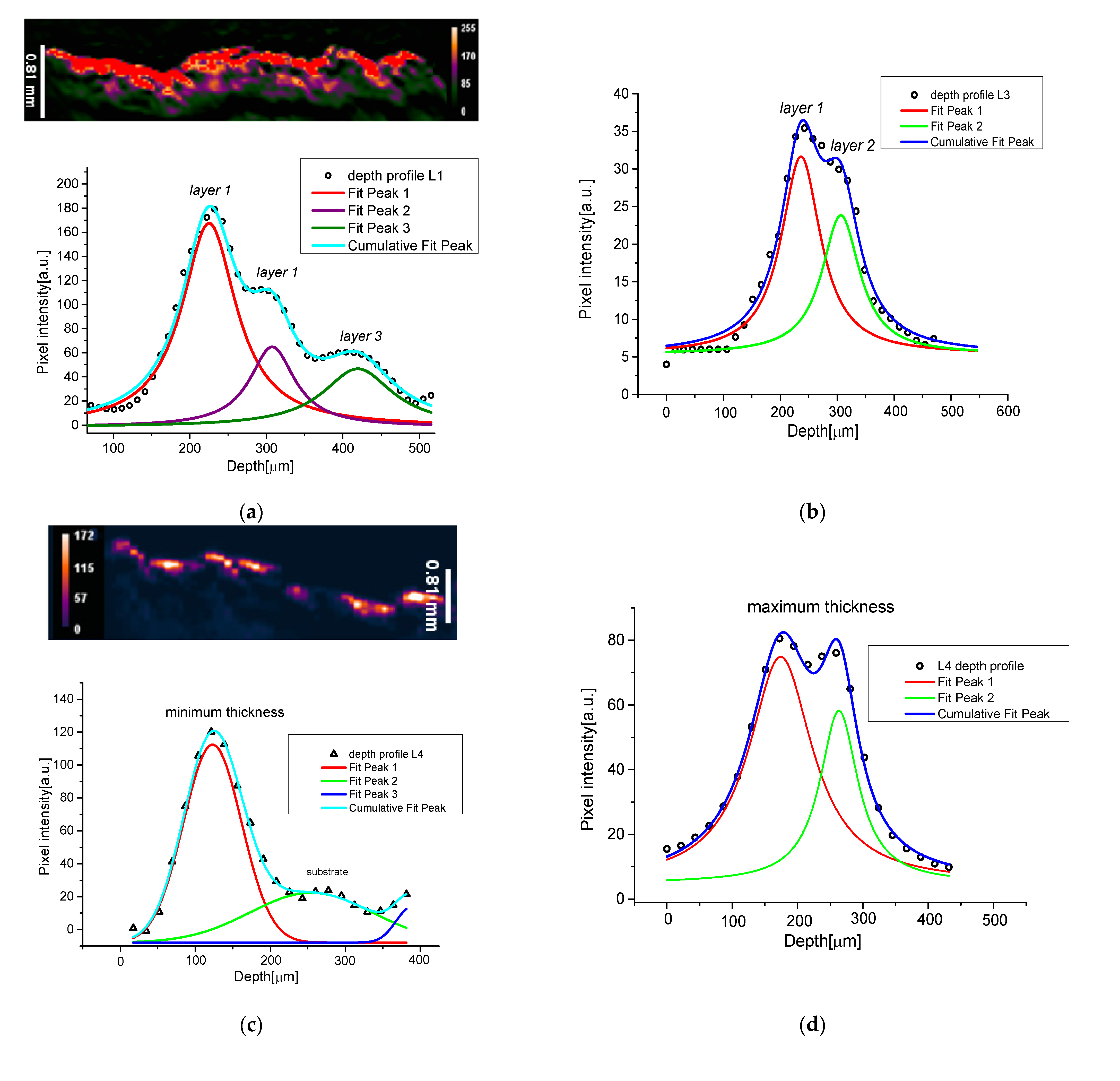

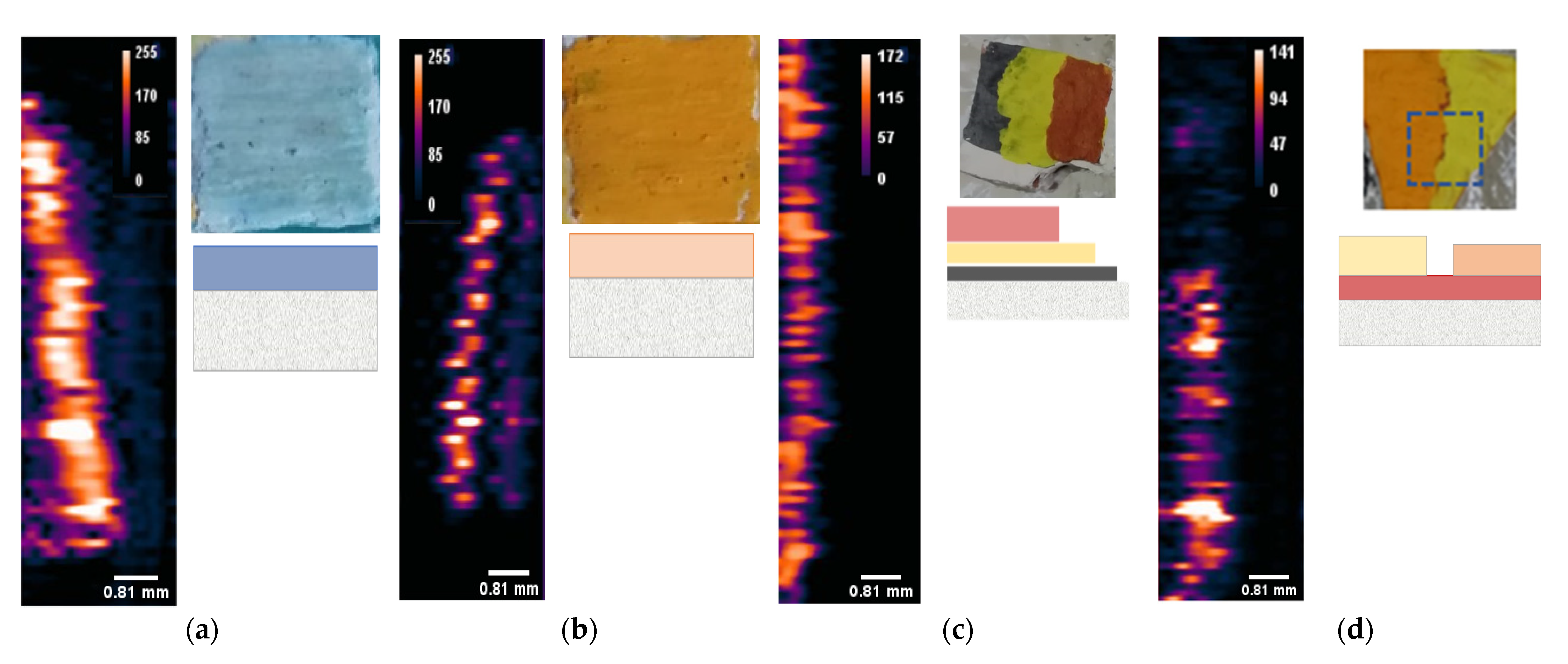
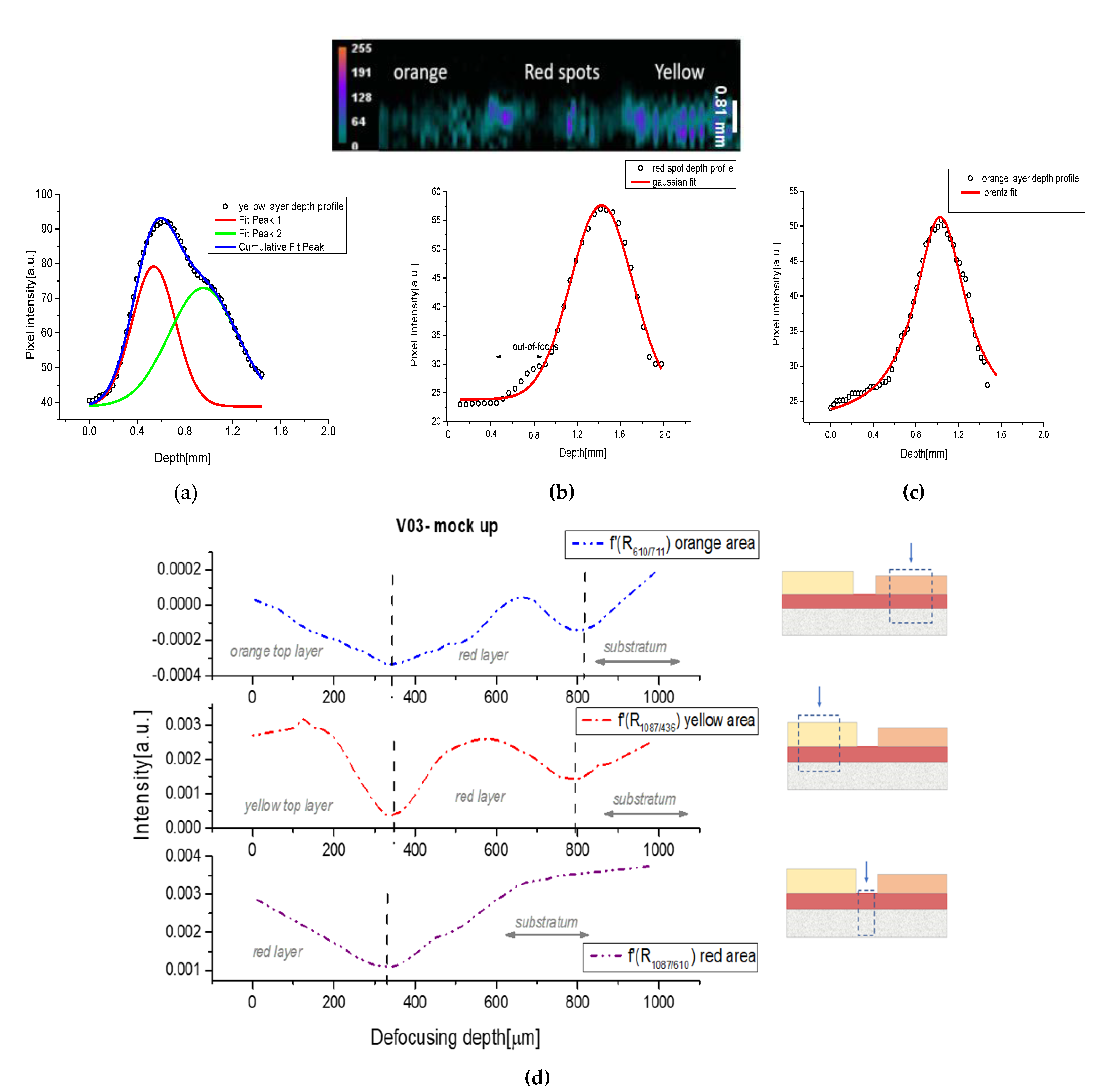


| Fresco Fragments from San Giuseppe Church | |||
|---|---|---|---|
| Sample | Substratum | Painted Region or Line | N° of Layers |
F.01 | Mortar, calcium hydroxide | L1 | 3 layers |
| L2 | 2 layers | ||
| L3 | 2 layers | ||
F.02 | Mortar, calcium hydroxide | L4 | 1 layer |
F.03 | Mortar, calcium hydroxide | L5 | 3 layers (same composition of L1) |
| Fresco Mock-ups | |||
| Sample | Substratum | Painted Area or Line | N° of Layers |
M.02 | Lime, sand, calcium hydroxide | Total area | 1 layer: lapis lazuli |
M.07 | Lime, sand, calcium hydroxide | Total area | 1 layer: cadmium orange (CdSeS) |
V.02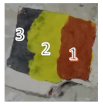 | Compact earthenware | Area 1 | 3 layers: graphite, cadmium yellow (CdS) and ochre |
| Area 2 | 2 layers: graphite, cadmium yellow | ||
| Area 3 | 1 layer: graphite | ||
V.03 | Compact earthenware | Area 1 | 2 layers: ochre and cadmium yellow |
| Area 2 | 2 layers: ochre and cadmium orange | ||
| Area 3 | 1 layer: ochre (between yellow and orange) | ||
| SEM analysis | |||||
| L1 | L3 | L4 | |||
| 1st layer [] | 2nd layer [] | 3rd layer [] | 1st layer [] | 2nd layer [] | 1st layer [] |
| PA analysis | |||||
| L1 | L3 | L4 | |||
| 1st layer [] | 2nd layer [] | 3rd layer [] | 1st layer [] | 2nd layer [] | 1st layer [] |
Disclaimer/Publisher’s Note: The statements, opinions and data contained in all publications are solely those of the individual author(s) and contributor(s) and not of MDPI and/or the editor(s). MDPI and/or the editor(s) disclaim responsibility for any injury to people or property resulting from any ideas, methods, instructions or products referred to in the content. |
© 2023 by the authors. Licensee MDPI, Basel, Switzerland. This article is an open access article distributed under the terms and conditions of the Creative Commons Attribution (CC BY) license (https://creativecommons.org/licenses/by/4.0/).
Share and Cite
Pisu, F.A.; Chiriu, D.; Klironomou, E.; Zacharakis, G.; Tserevelakis, G.J. Stratigraphy of Fresco Paintings: A New Approach with Photoacoustic and SORS Imaging. J. Imaging 2023, 9, 16. https://doi.org/10.3390/jimaging9010016
Pisu FA, Chiriu D, Klironomou E, Zacharakis G, Tserevelakis GJ. Stratigraphy of Fresco Paintings: A New Approach with Photoacoustic and SORS Imaging. Journal of Imaging. 2023; 9(1):16. https://doi.org/10.3390/jimaging9010016
Chicago/Turabian StylePisu, Francesca A., Daniele Chiriu, Evgenia Klironomou, Giannis Zacharakis, and George J. Tserevelakis. 2023. "Stratigraphy of Fresco Paintings: A New Approach with Photoacoustic and SORS Imaging" Journal of Imaging 9, no. 1: 16. https://doi.org/10.3390/jimaging9010016
APA StylePisu, F. A., Chiriu, D., Klironomou, E., Zacharakis, G., & Tserevelakis, G. J. (2023). Stratigraphy of Fresco Paintings: A New Approach with Photoacoustic and SORS Imaging. Journal of Imaging, 9(1), 16. https://doi.org/10.3390/jimaging9010016









